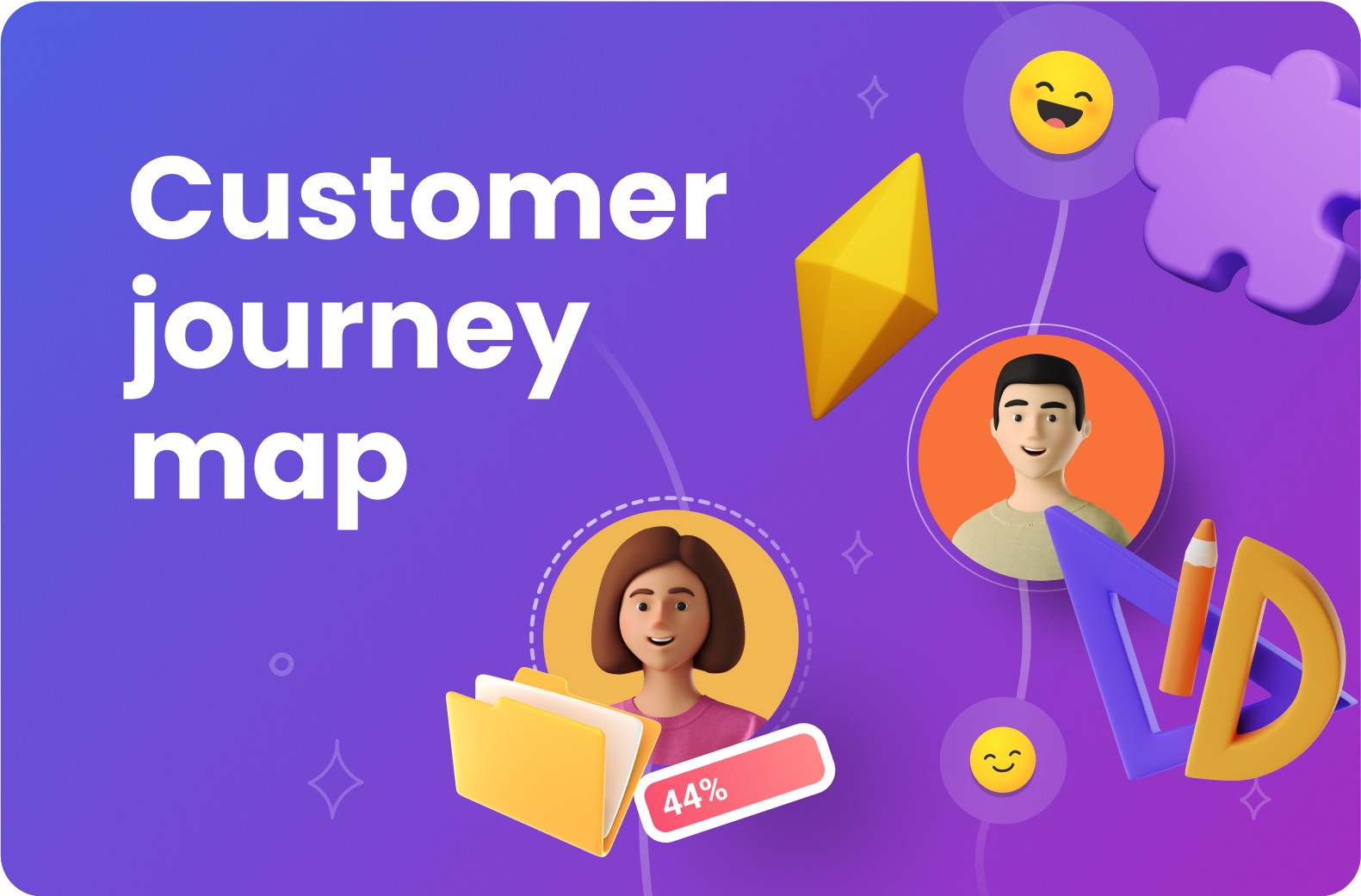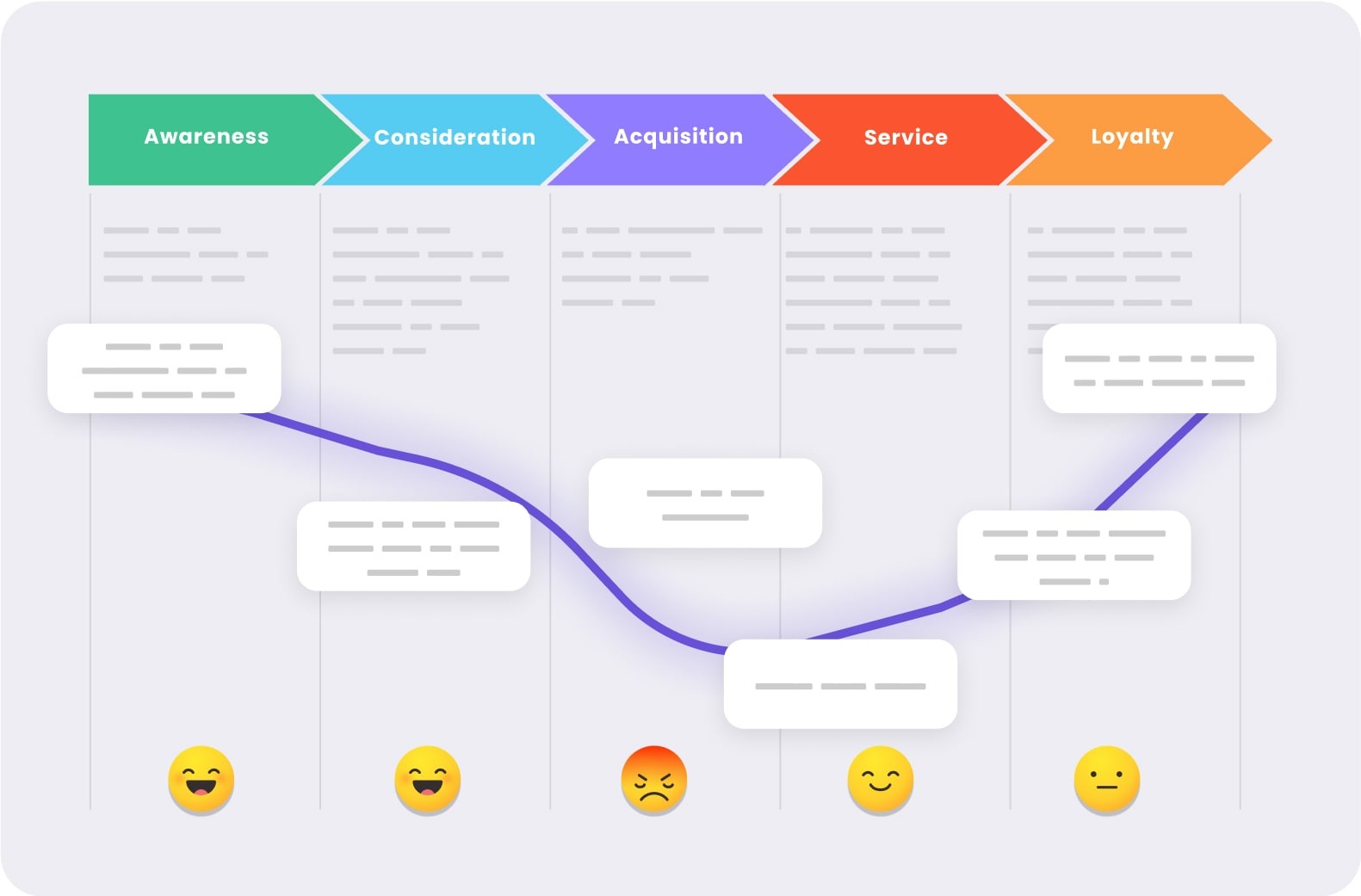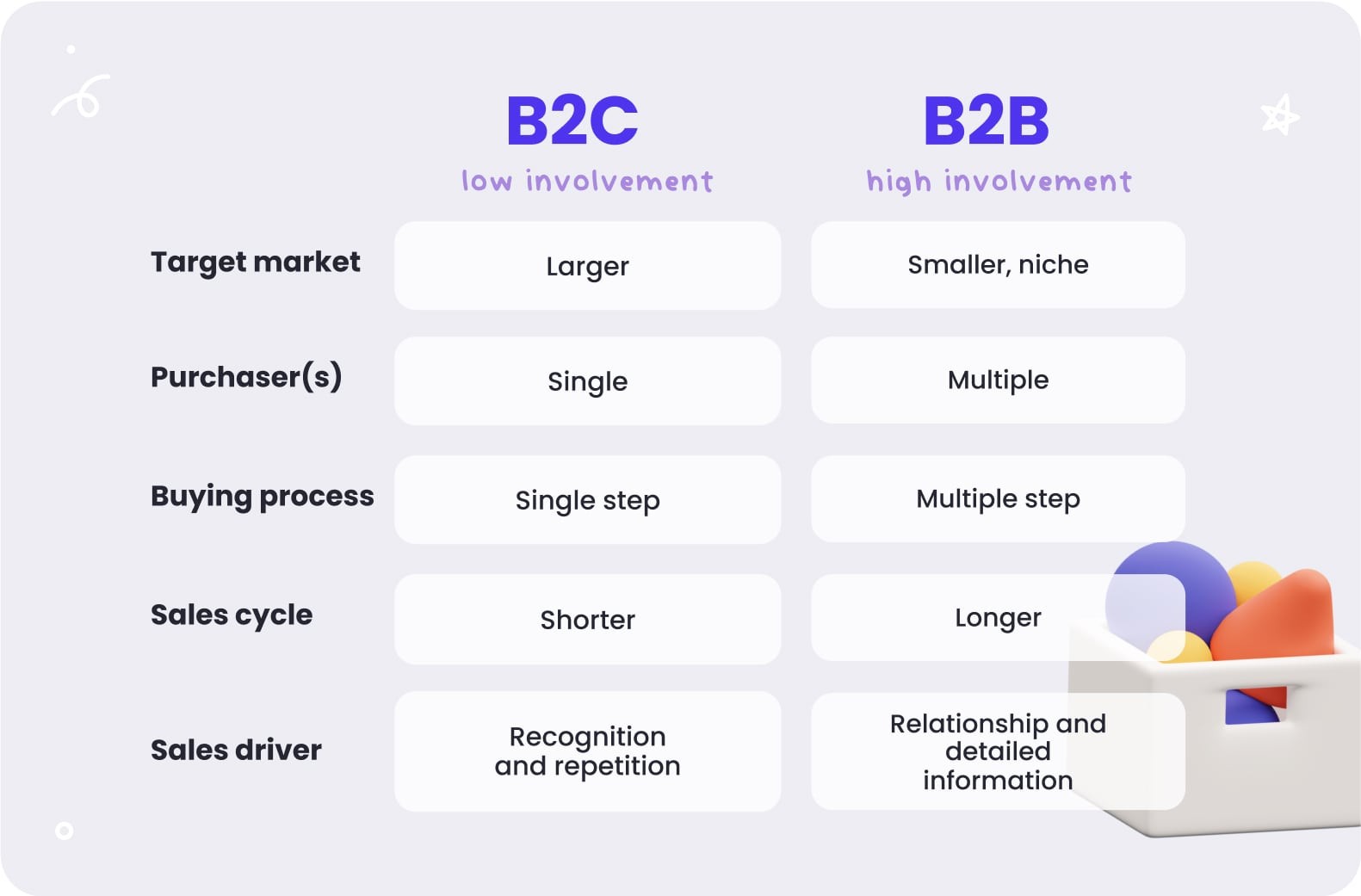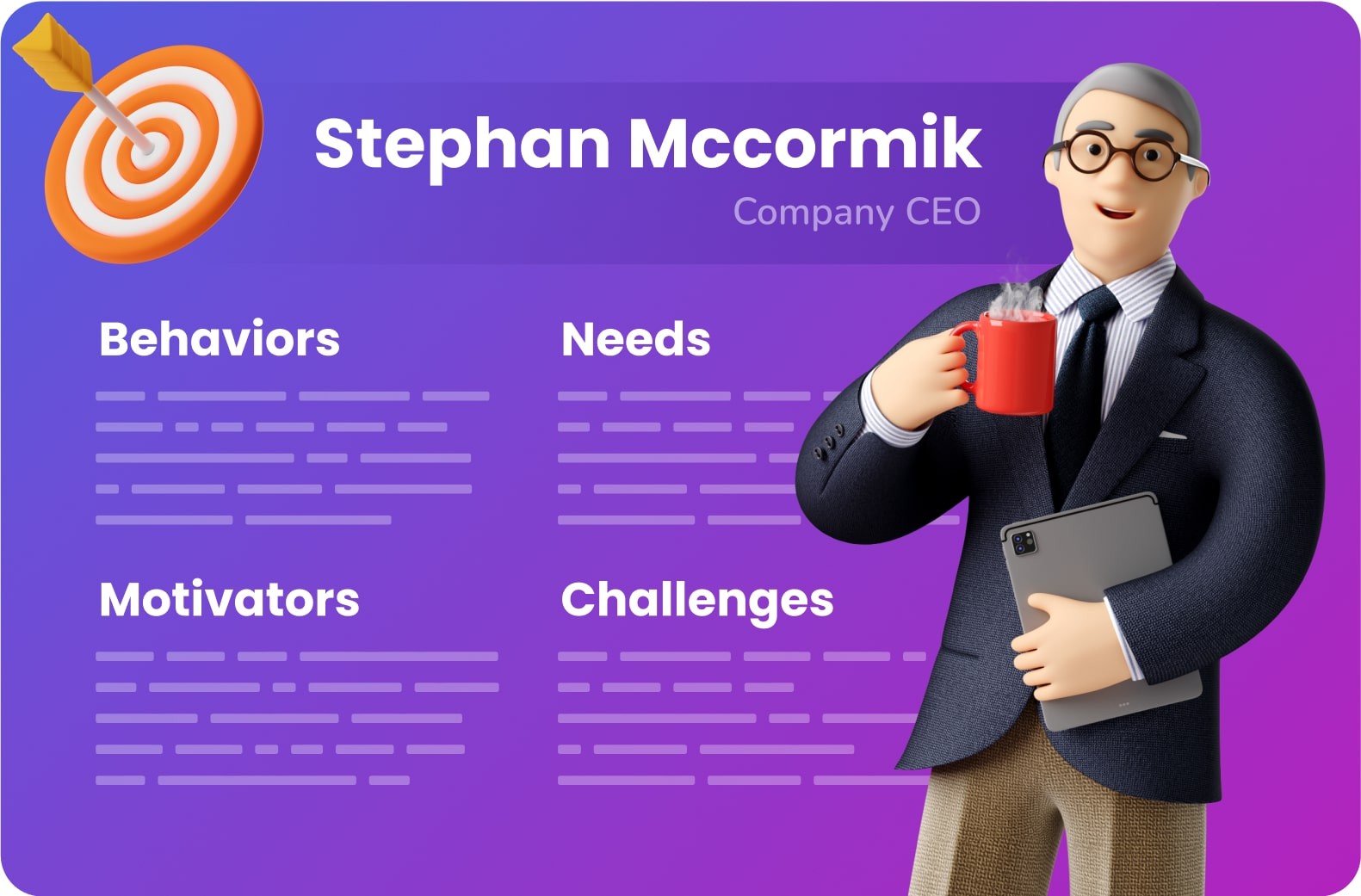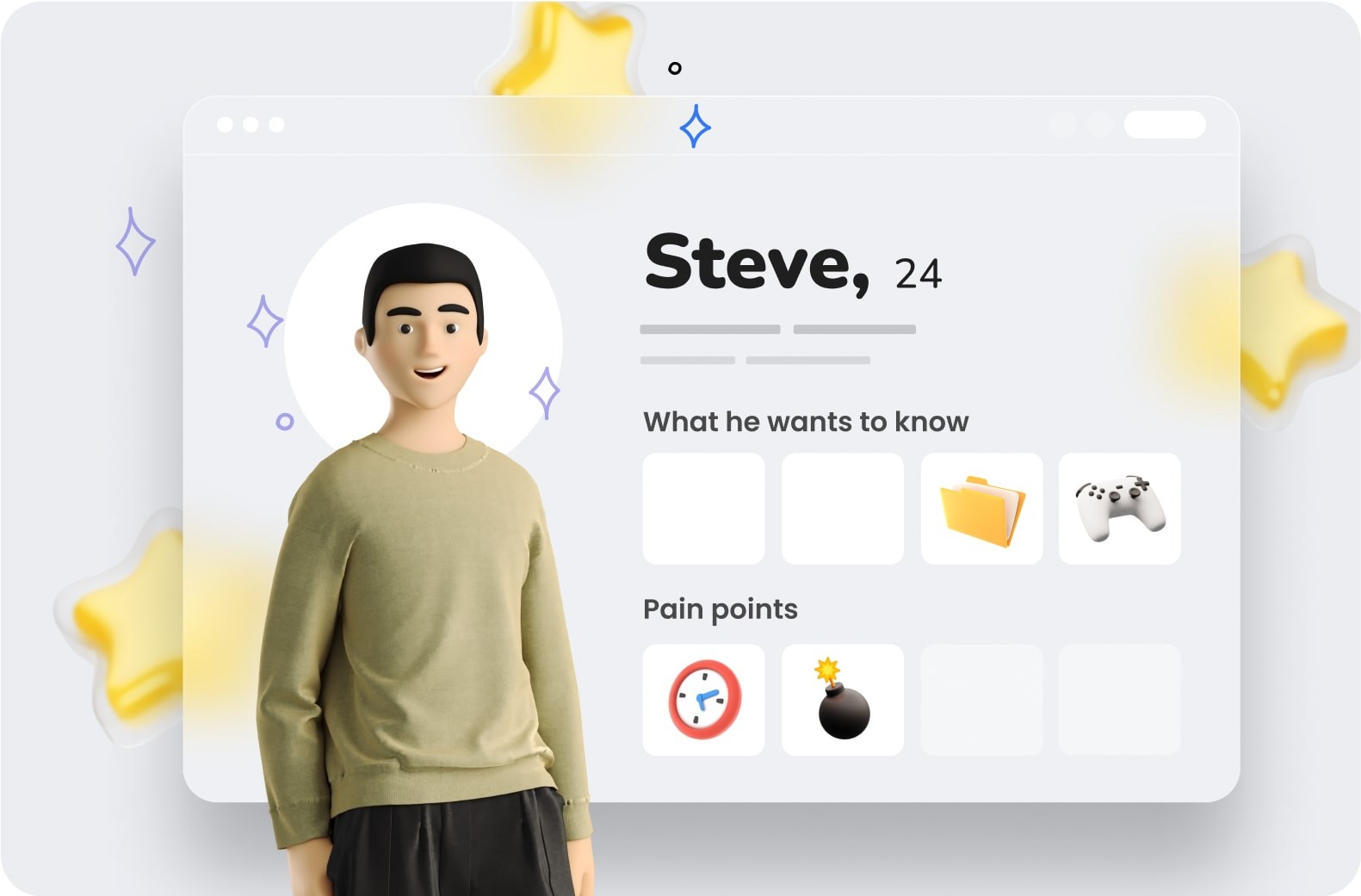A report by PWC highlights that more than 85% of buyers would pay more for a better customer experience. For consumers, this means convenience and friendly service.
Over half of the respondents we surveyed said that their needs weren’t being met- and this isn’t only for consumers. Businesses feel the same way. They want a top-notch experience.
This means that if you’re not giving your customers an excellent experience, you risk losing them to a competitor who does.
What is a B2B customer journey?
A B2B customer journey is the journey your business-to-business clients take from the moment they first learn about your brand to when they make a purchase and beyond. It’s the end-to-end customer experience.
What are customer journey maps?
A customer journey map is the record of all the interactions along the way for your buyers. It’s a comprehensive and organized overview of the entire customer experience. It is also known as a customer experience map, a user journey map, or a service blueprint. It’s the first step to understanding your customers, who are the biggest asset of any business.
Why is customer journey mapping important?
Understanding customer experience is the first step to improving it. Offering a high-quality experience is the only way to get a competitive edge in a market where over 30% of loyal customers will ditch a brand after a bad experience.
That means that customer retention and avoiding customer churn is based on meeting customer expectations. Customer loyalty is really about creating high-quality customer experiences. For most businesses, this means rethinking customer success – your customer service reps are an important part of your business retention strategy.
The differences between a B2B and B2C customer journey map
B2C stands for business to consumer. It’s when a business sells a product or service to a consumer. This is what individuals experience when they purchase a new iPhone, for instance. It’s greatly impacted by trends and demographics.
A B2C customer journey map can be complex as there are many different ways that customers interact with a brand in their personal life.
B2B stands for business to business. It’s any situation where two businesses make a commercial transaction with one another. Consumer trends are less impactful in this sphere, but there are business trends, too, that can impact B2B. For example, businesses have increased expectations for B2B customer experience. New technology means B2B buyers expect the same personalized experience they receive as consumers.
A B2B customer journey map is simpler in some ways since there may be fewer customer interactions, but putting yourself in your customer’s shoes can be harder when your customer is a business.
The benefits of B2B customer journey mapping
Customer journey mapping allows your company to better understand your customers. It allows you to map all the touchpoints your customers experience and identify gaps or areas for improvement.
With a comprehensive customer journey map, you can learn where your customers run into dead ends and better answer their questions. You can identify points where customers are dropping off along the customer journey and offer content tailored to their needs to keep them engaged.
Simply put, you can give every customer what they need when they need it, solve customer problems faster, give your business a tremendous advantage over your competitors, and much more.
Optimizing your B2B customer journey identifies missed opportunities, and taking advantage of those is the best way to grow your business.
Customer journey mapping is significant as it allows the business to move towards a customer-centric approach. It’s just a starting point to ensure that B2B customers have an excellent overall experience with the business. It can improve your overall customer engagement and retention, allowing you to get more out of each customer.
Unlike simple B2C customer journey maps, B2B customer journey maps can be very intricate. They are all about technical products and services, catering to multi-site requirements and providing personalized solutions. Ultimately, the process is worth it as it allows you to attract, upsell, convert, and retain more customers.
The key stages of a B2B customer journey
Every customer, whatever their business, will follow the following customer journey stages.
1. Awareness
The awareness stage is the initial stage for a B2B buyer. At this point, the potential buyer might be aware of their problem and looking for solutions or may not yet realize there are areas for improvement in their business model.
As a business, you need to ensure that you are present everywhere where a potential customer is looking. Talk about the problems you know your customers are facing and let businesses know you’re a solution.
Channels such as social media, event marketing, search engine marketing, and advertising are all examples of awareness. A combination of inbound marketing and outbound marketing (sales) tactics is useful at this stage in the user journey.
2. Consideration
At this stage of the B2B customer journey, the buyer sees the potential in what your organization has to offer. They are aware of their problem and understand your solutions. They are also likely considering many other companies, too. They are considering all their options.
3. Decision
At this stage, the buyer makes a decision. They narrow down the options that truly address their pain points and choose a product or service that will allow their firm to operate effectively and efficiently.
4. Conversion
Conversion is when the purchase is formally made. It’s also when the clock starts ticking on a delivery. The customer expects your solutions to start working as promised.
5. Engagement
This is the time after purchase when retention begins. It’s when you can ask for feedback or begin to suggest other content that can help them make the most of their purchase.
6. Advocacy
A satisfied B2B customer will begin to refer you to others. Word of mouth expands the customer pool, and the whole business grows.
7. Renewal
The customer journey never really ends and there is typically a time when customers purchase a new product or service from your business.
How to build a B2B customer journey map
Before you start putting boxes on a map, you need to understand who your customers are and what they want. Here are some things you should do before starting your customer journey map.
Create buyer personas
A buyer persona is a fictional person that represents your target audience or target customers. This persona is based on real information about the people who might buy your products. You can also call it a customer persona, audience persona, or marketing persona. It combines your own industry knowledge, competitor research, and real customer data.
Having a buyer persona provides you with an understanding of your audience’s motivations and habits. It allows you to determine what they need from your website and how your content marketing decisions should be made.
In addition, it helps with sales by guiding you to which channels work best for reaching potential customers and adapting your sales process correctly.
Customer personas can help you create more effective advertising campaigns and develop messages that resonate with specific groups within your target market.
Creating multiple buyer personas will help you determine which ones are most likely to respond favorably to various marketing initiatives so you can better allocate your budget accordingly. It allows you to look at things from your customer’s perspective so you can make decisions to improve customer satisfaction.
Understand your customer’s pain points
Once you understand your customer personas, it’s time to understand their pain points. Work on anything that can improve your customer experience at every stage of the customer’s journey, such as making the process of purchasing your product or service easy. Every interaction between the client and business increases its chances of turning leads into conversions.
Try to understand the problematic customer touchpoints and the opportunities to provide a more positive customer experience.
Does your online form ask too many questions? Is your site’s search function difficult to use? These small issues throughout the customer journey can be major pain points for your users.
5 steps to building your B2B customer journey map
There are a few key elements for creating customer journey maps that need to be useful. As you undertake this customer journey mapping exercise, try to keep in mind your target customer personas. The goal is to maximize customer success at each customer touchpoint.
1. Identifying The Buyers and Their Goals
To succeed in B2B, a business must look at the needs and goals of multiple people. A business is comprised of a group of people and each has its own requirements and pain points. Understanding this is the first step toward creating a customer journey map.
What is the goal of your customer? What problem are they trying to solve? Write this goal clearly at the top of your customer experience map or use a visual representation of the goal. If you have multiple customer segments, consider whether their goals are the same and if you may need a unique customer journey map for each one.
2. Conduct research
Data and analytics offer valuable insight that is key to customer journey mapping. As an organization, you can use it to your benefit and make solid, data-driven decisions instead of subjective analysis. Survey your customers to find out what their pain points really are and how they interact with your brand.
3. Create a Customer Journey mapping template
Use the customer journey stages that we have already discussed to create a customer journey map template. Look at customer journey map examples online to identify ways to represent these stages visually. An effective customer journey map should be easy to fill in and use. It must also be flexible to change it as you learn new things about your buyers and their pain points.
4. Write out All your customer Touchpoints
A touchpoint is any point where a customer interacts with the business. You should analyze all the points that a customer is expected to make engaging with you. These are any engaging points that a client has with the company. For instance, conversations with the support team for any queries, viewing posts on social media, filling out forms on the website, or reading the company blogs.
Begin adding these points to your customer journey map template. Keep in mind the customer journey mapping process is constantly in flux – as your customer moves through the journey, they may have multiple touchpoints – so the path may not be direct.
5. Define Your Business Goals
If the customer journey mapping exercise begins with your customer, it ends with your business. The basic objective of B2B customer journey mapping is to understand how to provide the best customer experience. And for that, you need to outline what defines “good customer experience” and what it is that you should be offering that will ensure that customers have a good one.
For guidance, look to competitors for a customer journey map example. Ask yourself these questions. What does the buying process look like? What is the product or service they come away with? What problem are you solving for them? The end of your customer journey map is the culmination of your hard work.
Customer journey map design
Once you’ve done all the above, it’s time to design your map. Although a customer journey map is a visual representation of the steps people go through to achieve their goals, it’s not all about the design.
The purpose of a customer journey map is not to impress your team members with cool diagram visualizations but rather to provide your team with a document they can use to make strategic decisions about customer experience.
Customer journey map templates
Need help with your customer journey map? You can certainly create your own document to list out the stages of your customer journey, but there are also plenty of interactive customer journey map templates available for you.
Don’t waste time on the visuals – use existing customer journey map examples to help you get started quickly so you can get back to growing your business.
The real purpose of your customer journey map
Don’t reinvent the wheel — use customer journey map templates and customer journey map examples to build your own. Customer journey maps are useful because they give us a bird’s-eye view of how customers engage with our products or services and what we can do to improve their experience along the way. It is a blueprint of the buying process.
The changing B2B landscape requires businesses to be upfront, updated, and always ready. By identifying the customer journey taken before purchase, you can determine who your target audience is and what factors influence their decision-making process.
The customer journey map should be a living document that you can use to guide your marketing activities. It will help you identify what steps are involved in the buying process and how they relate to different audiences.
Bonus: Create a service blueprint
It’s important not to forget about your existing customers. As you explore the customer journey, consider the stages after purchase.
Are there parts of your customer support process or the buying process that could be improved? Retaining an existing customer is much cheaper than finding a new one, so be sure to explore the customer journey after they make their purchase.
Consider creating a service blueprint that identifies different touchpoints in your service funnel, communications customers receive, and the support actions that take place to resolve issues.
Using a customer journey map to improve the customer experience at any stage
As an organization, you need to act differently at every stage of the B2B customer journey, but there are things you can implement at every stage.
1. Better meet buyer needs at every stage of the customer journey
First and foremost, you’ll need to understand what the customer expects. Creating a customer journey map is about understanding the experience of your ideal customer persona. Often businesses still run on a product-orientation approach, which is basically producing a good and then trying to sell it to the customers irrespective of the fact that whether it addresses their issues or not.
The B2B customer journey allows you to understand that it’s a market-orientation approach that you should be using to ensure that what you offer equates to what the buyer is asking for.
It is also crucial to understand the B2B customer journey because they make informed decisions. Unlike B2C customers, who might be disappointed by one decision but can easily find another company to buy products from, businesses have a harder time recovering from poor decisions. So, you should feel that pressure on your own and make sure that the project delivers what it promises.
Continuously ask yourself what your customer needs and wants at each stage of the customer journey to ensure you’re meeting it. Consider collecting regular feedback from your customers so that you are on top of changing trends in the industry.
2. Personalize customer experiences
Customization is the key for the B2B buyer. The same products aimed at B2C customers can be sold at various places, but that’s not the case with B2B customers. Every business has varying requirements, and the same size shoe won’t fit all.
B2B buyers can be challenging to attain, let alone retain if you don’t offer them the solution they are seeking. However, they can be easily captured when you are willing to make a personalized offer to them. Leverage customer insights and feedback to offer them exactly what they want, when they want it.
Survey customers and study customer behavior to find ways you can better support customers. Try to understand your customer’s points of view and develop business processes that empower them.
3. Use technology to your advantage all along your customer’s journey
Make technology your best friend. With so many options of customer service technology in the market, as an organization, you can stay connected with your B2B buyers at all times. Customer data can be used to automate simple tasks, and tools such as chatbots can be used to answer the queries of the customer as soon as they send one.
Customer journey mapping helps you identify gaps so you can address pain points better. Most importantly, be sure to leverage new tools, like Screver, to collect information about the customer experience along the way.
The platform allows you to get feedback quickly and easily from your customers at every stage of the buyer journey. It saves you time on long, boring surveys and feedback campaigns and instead adds value to you and your customers in a fun way.
4. Optimize your website for stellar customer experiences
In the modern age, your customer’s experience is defined by their experience on your website. Online presence can’t be ignored as it is vital for business visibility and growth and becomes a source to connect to customers.
Optimizing the website will mean that its interface is user-friendly, so the buyers don’t have a hard time navigating through the website. Moreover, the website content can be customized, too, by using algorithms to suggest to them what they are already looking for.
Creating a customer journey can help you identify important touchpoints on your website so you can make changes accordingly. Design a website your customers will love and continue to improve it with technology. We recommend using a customer feedback tool, like Screver, to collect information on the Voice of the Customer and plan your updates and designs around their feedback. Use your customer journey map to identify key content or areas of the site that can be improved for each stage of the customer journey.
5. Encourage customer journey feedback from the source
Collecting customer feedback is an important practice for ensuring that a customer has a good experience with the business at every stage of the customer journey. In fact, this further strengthens their relationship and ensures that the organization continues to cater to customers’ needs.
Regularly asking them about their experience is a great way to build that crucial connection with your customers. If you stay in touch with your customers, they’ll be more likely to tell you about any problems right away. That way, if a problem arises again (and it probably will), you can resolve it immediately and prevent similar issues from happening down the road.
Companies can also use tools like Screver to collect feedback from their customers and users. These tools offer one-
off surveys, pulses, and quizzes that are fun and easy for people to interact with —allowing them to share their thoughts on products or services in just a few clicks! Use your customer experience maps to identify key points where you can collect feedback.
Key takeaways
When done properly, creating and using a customer journey map can be instrumental in your business. If you’re lucky, you’ll use this as a template for future customer journeys across your B2B company. And if you don’t go down that route, at least you’ll have created a document that your teams can refer to when they’re considering changes in product features or development. Either way, it will help your team make strategic decisions about how you’re going to best meet your customer needs.
With B2B customers being more informed and asking for a more personalized experience, businesses are left with no option but to deliver. The B2B customer journey is an essential part of a company’s long-term relationship with its customers.
It allows businesses to work on innovative and thoughtful ideas that satisfy current needs while anticipating future ones. In the B2B realm, customer sentiments and satisfaction are crucial to a business’s success. The smarter companies let this guide them as they refine their products or services so that customers receive what exactly is needed when they need it.
So, get started today on better understanding your customers’ needs and bringing in more business with the right B2B customer journey map!
